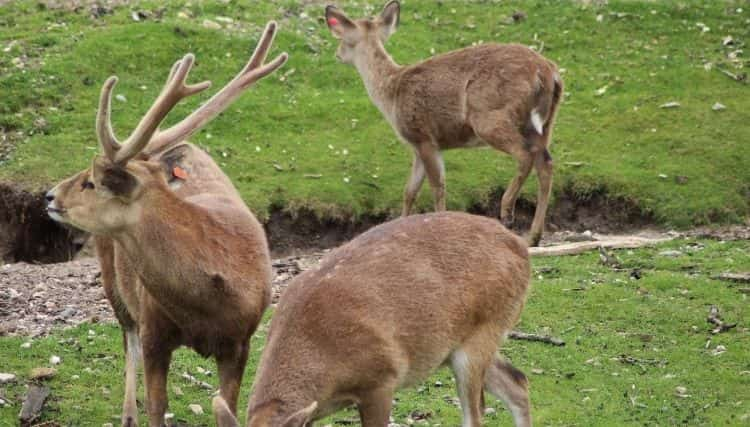
It can be tough to get the information you need about animals. If you’ve ever wanted to know all there is to know about Hog Deer Facts, then this guide is for you.
What is a Hog Deer?
The Hog Deer (Axis porcinus) is a species of deer that is native to the Indian subcontinent and Southeast Asia.
Hog Deer are relatively small compared to other deer species, standing about 60-70 cm tall at the shoulder and weighing between 40-50 kg. They are named for their habit of wallowing in mud, which is thought to protect them from parasites and regulate their body temperature.
Male Hog Deer have antlers that are typically three-pronged and about 30-40 cm long. They are primarily solitary and territorial, with males using their antlers to defend their territory during the breeding season.
Geographic Range
The Hog Deer (Axis porcinus) is native to the Indian subcontinent and Southeast Asia. Its range includes parts of India, Nepal, Bangladesh, Bhutan, Myanmar, Thailand, Cambodia, Vietnam, and Laos. Within this range, Hog Deer are found in a variety of habitats, including grasslands, forests, and wetlands.
Their preferred habitats are areas with tall grasses and dense vegetation, as well as areas near water sources such as rivers, swamps, and lakes.
Habitat
Hog Deer (Axis porcinus) are adapted to living in a variety of habitats, including grasslands, forests, and wetlands. They prefer areas with tall grasses and dense vegetation, as well as areas near water sources such as rivers, swamps, and lakes.
In India, Hog Deer are found in grasslands, savannas, and forests, as well as wetland habitats such as the Sunderbans mangrove forest. In Southeast Asia, they are found in a variety of habitats, including tropical rainforests, bamboo forests, and open grasslands.
Hog Deer are also known to be able to adapt to human-modified habitats, such as agricultural fields and plantations. However, they are threatened by habitat loss and fragmentation due to agriculture, logging, and urbanization. Conservation efforts are underway to protect their remaining habitat and to restore degraded areas.
Physical Description
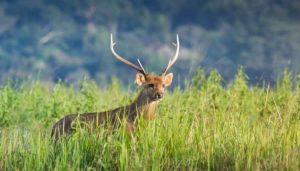
Hog Deer (Axis porcinus) is relatively small compared to other deer species, standing about 60-70 cm tall at the shoulder and weighing between 40-50 kg. They have a compact and muscular body, with short legs and a short tail.
The coat of Hog Deer is short and coarse, and is typically reddish-brown, with white spots on the upper body and legs. The belly and underside of the tail are white.
Male Hog Deer have antlers that are typically three-pronged and about 30-40 cm long. The antlers are shed annually and grow back during the breeding season. Females do not have antlers.
Hog Deer have a distinct white ring around their eyes and a white throat patch, which helps to distinguish them from other deer species. They also have large ears that are rounded at the tips.
Overall, Hog Deer has a unique and distinctive appearance, adapted to their preferred habitats and lifestyle.
How long does a Hog Deer live?
The lifespan of a Hog Deer (Axis porcinus) in the wild is typically around 10-12 years, although some individuals have been known to live longer.
In captivity, Hog Deer have been known to live up to 20 years, although this is rare. Factors such as habitat quality, availability of food and water, and predation can all affect the lifespan of wild Hog Deer.
Female Hog Deer typically have a shorter lifespan than males, due in part to the stresses of reproduction and caring for young. However, both males and females can be affected by habitat loss, hunting, and other human activities threatening their survival.
Hog Deer Reproduction -Breeding
Hog Deer (Axis porcinus) typically breed during the winter months, from November to January. During this time, males become more territorial and aggressive, using their antlers to defend their territory from other males.
Male Hog Deer will mark their territory by rubbing their antlers against trees and shrubs, and by urinating and defecating in certain areas. They will also make vocalizations, including grunts and roars, to attract females and intimidate other males.
When a female enters a male’s territory, he will try to court her by displaying his antlers, making vocalizations, and following her closely. If the female is receptive, she will allow the male to mate with her.
Gestation in Hog Deer lasts for around 200-220 days, after which the female gives birth to a single fawn, although twins are not uncommon. The fawn is typically born in dense vegetation, where it can be hidden from predators. The mother will leave the fawn hidden for several hours at a time while she goes off to feed, returning periodically to nurse the fawn.
The fawn is born with a spotted coat, which helps to camouflage it in its surroundings. After a few months, the spots will fade and the fawn will resemble an adult Hog Deer.
Fawns will stay with their mother for up to a year, after which they will become independent. Females can begin reproducing at around one year of age, while males typically begin breeding at around two years of age.
Communication and Perception
Hog Deer (Axis porcinus) use a variety of vocalizations and body language to communicate with one another. Male Hog Deer use grunts, roars, and other vocalizations to establish their dominance and attract females. Females use vocalizations to communicate with their young and with other females in their social group.
Hog Deer also use body language to communicate. When threatened, they may raise their tails, exposing the white underside, to signal danger to other deer in the area. When alert, they may freeze or raise their heads to get a better view of their surroundings.
In addition to vocalizations and body language, Hog Deers also have a keen sense of smell and hearing, which they use to detect predators and other threats. They are also able to see in color, which helps them to navigate their environment and find food.
Overall, Hog Deer have a range of communication and sensory abilities that allow them to navigate their environment and interact with other deer in their social group. These abilities are essential for their survival in the wild.
What do hog deer eat?
Hog Deer (Axis porcinus) are herbivores and primarily feed on a variety of plants, including grasses, leaves, and fruits. Their diet can vary depending on the season and the availability of food in their habitat.
In the dry season, when food is scarce, Hog Deer may feed on a variety of woody plants, including shrubs and tree bark. During the wet season, when plants are more abundant, they may feed on a wider variety of grasses and other vegetation.
Hog Deer are also known to feed on crops, such as rice and sugarcane, which can bring them into conflict with farmers. In some areas, this conflict has led to the decline of Hog Deer populations and efforts are being made to reduce human-wildlife conflict and to develop sustainable land use practices that can benefit both wildlife and people.
Overall, Hog Deer have a diverse diet that allows them to adapt to changes in their environment and to survive in a variety of habitats.
Anti-predator Adaptations
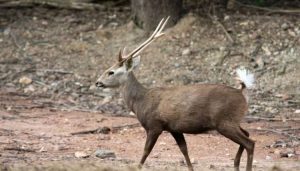
Hog Deer (Axis porcinus) have several adaptations that help them avoid predation and survive in their habitat. These adaptations include:
- Camouflage: Hog Deer have a reddish-brown coat with white spots that provides excellent camouflage in their natural habitat, helping them blend in with the vegetation and avoid detection by predators.
- Agility: Hog Deer has a compact, muscular body and short legs, which give them a low center of gravity and allow them to maneuver quickly and easily through dense vegetation. They can also run at speeds of up to 70 km/h (45 mph), allowing them to outrun many predators.
- Vigilance: Hog Deer have large, sensitive ears and excellent eyesight, which they use to detect predators from a distance. They are also known to raise their tails when they sense danger, which serves as a warning signal to other deer in the area.
- Group living: Hog Deer are social animals and often live in small herds, which can help protect them from predators. By living in groups, they can keep watch for predators and can also cooperate to defend themselves against attacks.
- Wallowing behavior: Hog Deer are known to wallow in mud, which may help to protect them from biting insects and parasites, as well as to cool their body temperature. This behavior may also help to mask their scent and make them less detectable to predators.
Ecosystem Roles
Hog Deer (Axis porcinus) play an important role in their ecosystem, as they are herbivores that help control vegetation growth and maintain biodiversity. By feeding on a variety of plants, including grasses and woody vegetation, they help to shape the structure and composition of their habitat.
In addition to their role as herbivores, Hog Deer also serve as prey for several predators, including tigers, leopards, and wild dogs. By providing a source of food for these predators, Hog Deer help to maintain the balance of predator-prey relationships in their ecosystem.
Furthermore, Hog Deer is an important cultural and recreational resource in many parts of their range. They are valued for their meat, which is consumed by local communities, and for their aesthetic and recreational value, which attracts tourists and hunters.
Overall, Hog Deer play an important ecological, cultural, and recreational role in their ecosystem. They are part of a complex web of relationships and interactions that help to maintain the health and vitality of their habitat.
Conservation Status
Hog Deer (Axis porcinus) is listed as a vulnerable species by the International Union for Conservation of Nature (IUCN). Their populations have declined significantly in recent decades due to habitat loss, hunting, and human-wildlife conflict.
The main threats to Hog Deer populations are habitat loss and fragmentation, primarily due to agricultural expansion and urbanization. They are also hunted for their meat and antlers, which are valued in traditional medicine.
Conservation efforts for Hog Deer include the establishment of protected areas, habitat restoration, and the implementation of sustainable land use practices. In addition, efforts are being made to reduce human-wildlife conflict, through measures such as the construction of fencing and the provision of alternative livelihoods for local communities.
Overall, the conservation status of Hog Deer remains a concern, and continued efforts are needed to protect and restore their populations in the wild. By addressing the threats to their habitat and implementing sustainable conservation practices, we can ensure the long-term survival of this important species.
Referans: Abundance and population genetics of Hog Deer (Axis porcinus) in Victoria
Where are hog deer in Australia?
This species of hog deer is native to the eastern and southern regions of Australia.
Why is hog deer endangered?
The main factors leading to their endangerment are habitat loss, introduction of exotic species in their natural habitat, and hunting for bushmeat.
Where do Hog Deer sleep?
Their habitat ranges from scrub forests to high-altitude grasslands. The hog deer is nocturnal in nature and they often sleep during daytime on a bed of grass or leaves.
What plants do Hog Deer avoid?
The main reason why they avoid certain plants is because of their chemical make-up; these plants either have natural poisons or contain chemicals that can cause illness when consumed by animals like hog deer.
The list of plants that hog deer avoid is as follows:
1) Tender leaves
2) Collyrium plant
3) Lettuce leaf
4) Amaranth leaves
5) Bengal gram leaves
Can Hog Deer swim?
Yes, Hog Deer can swim. They do so in the water to avoid predators.
İs Hog Deer Aggressive?
The Hog Deer is not an aggressive animal.But The Hog Deer is aggressive when defending itself or its young.
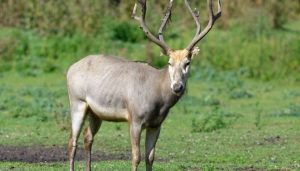
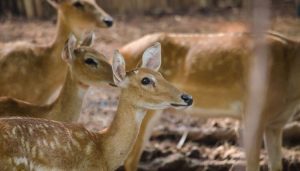
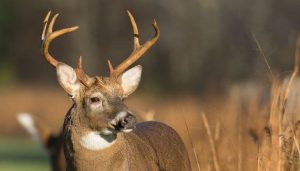
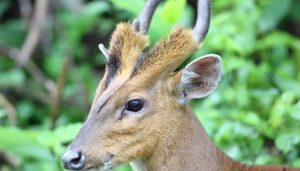

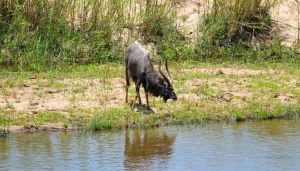
Leave a Reply